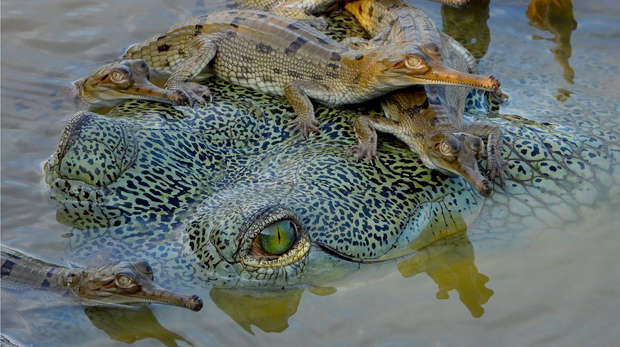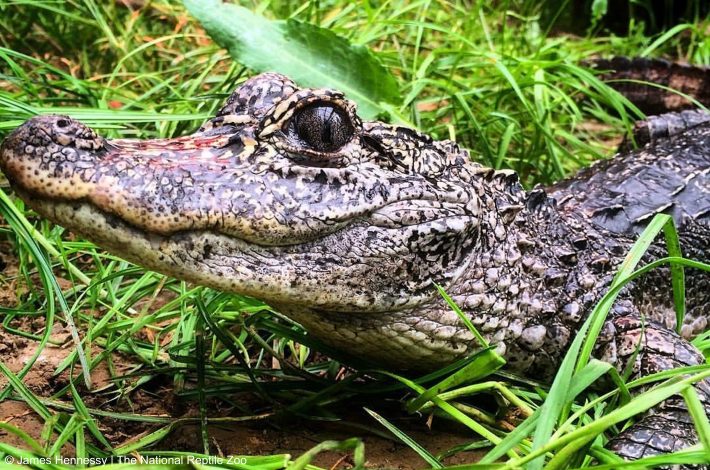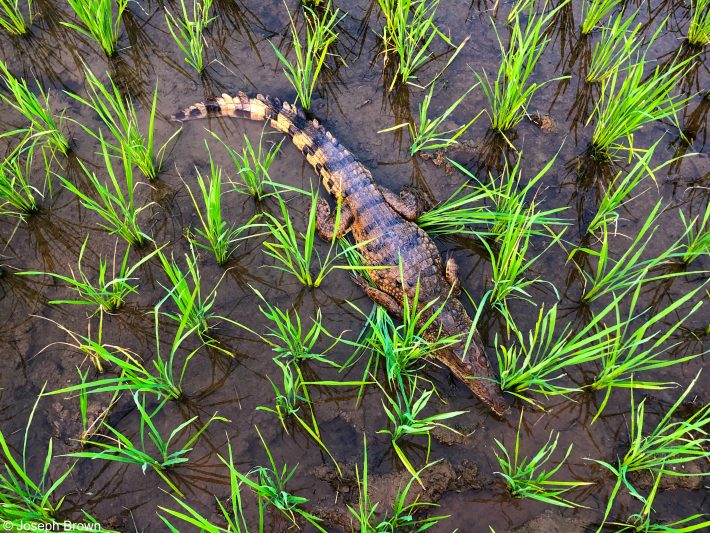The irreplaceable roles of crocodiles and relatives are at risk of being lost
ZSL press release.
As the risk of extinction for crocodilians grows, these well known species are not the only thing we stand to lose. New research in the British Ecological Society’s Journal Functional Ecology highlights the unique roles these reptiles fulfil in their respective ecosystems are also at risk.

Creating shelter for other animals through unique burrow systems and crunching down on invasive, agricultural pests are just two vital services that stand to be lost if the world’s crocodiles and alligators are not better protected, according to new research led by ZSL (Zoological Society of London).
Up to 38% of the diverse ecological functions that crocodilian species provide for wider ecosystems are at risk of being lost, say researchers in a first-of-its-kind study.
Published in Functional Ecology, the study identifies the species of crocodile, alligator, caiman and gharial most in need of conservation action. They each play important, but different and diverse roles in the ecosystems in which they live, leading authors to call for greater conservation protections for these highly threatened species, based on their unique ecologies.
If we lose these species, we stand to lose the important roles they play, forever
The study investigates the diversity of crocodilian ecological roles by looking at measurable characteristics linked to how species function in their environment, such as skull shape, body size and habitat use. The researchers developed a database of these key characteristics for all species, revealing often-surprising ecological functions performed by the crocodilians.
From the prolific burrowing of the Critically Endangered Chinese alligator (扬子鳄; Alligator sinensis)—which provides vital shelter and refuge for other species—to controlling agricultural pests such as in the case of the Philippine crocodile (Crocodylus mindorensis, known locally as the Buwaya), which eats the invasive apple snail; crocodilians are vital engineers of the ecosystems in which they live. Some, like the world’s largest crocodile, the saltwater crocodile (Crocodylus porosus), travel hundreds of kilometres across open ocean, traversing critical terrestrial, freshwater and marine habitats, transporting nutrients between ecosystems.

Over half of all crocodilians are threatened with extinction due to loss of habitat, hunting, bycatch in fishing gear and damming of rivers. Losing these threatened species means that we would lose the diverse ecological roles they provide, with unknown, and potentially devastating ecological consequences.
Many of the crocs we highlight as ecologically distinctive are also the species at immediate risk of extinction
The researchers, hailing from ZSL’s Institute of Zoology (IOZ) and EDGE of Existence programme, the Wildlife Conservation Research Unit at the University of Oxford, and the Gharial Ecology Project in India discovered that certain species have particularly unique ecologies, such as the Critically Endangered gharial (Gavialis gangeticus). The gharial is an aquatic species specially adapted to life in the water with a long and narrow snout ideal for catching fish- its primary prey. Its presence is indicative of clean and healthy water systems.
ZSL PhD student and lead author, Phoebe Griffith said: “Many people think of crocodilians as large predators, grabbing zebra in wildlife documentaries – but that’s just a small part of the behaviour of a single species. There are around twenty-eight species of crocodilian, and they’ve evolved to be surprisingly different to one another.
“Quantifying the diverse ecological roles of these species is an important factor in understanding and conserving global biodiversity and looking at the scale of what we are set to lose if these key players disappear.”
“If we lose these species, we stand to lose the important roles they play, forever. We are only just beginning to investigate what these roles are, but some species may be lost before we have a chance to understand their place in the ecosystems they are found. This is especially worrying as many of the crocs we highlight as ecologically distinctive are also the species at immediate risk of extinction.”

Out of the ten species with the most unique ecological functions, six are Critically Endangered and are so depleted that they are considered functionally extinct in most of their historical range. The two most threatened species —the gharial and Chinese alligator—are also highly evolutionarily unique and highlighted by ZSL’s EDGE of Existence programme as priority EDGE (Evolutionarily Distinct and Global Endangered) species. The study found that conserving threatened crocodilians based on their evolutionary uniqueness would also have a positive impact on conserving the functional diversity of the species worldwide.
EDGE Postdoctoral Research Scientist, Dr Rikki Gumbs said: “From miniature burrowing alligators to giant sea-faring crocodiles, the vast evolutionary journey of crocodilians has produced a dazzling variety of shapes, sizes and behaviours. Sadly, many of the world’s most unique crocodilians are in decline and, along with the functions they perform in their ecosystems, are on the brink of being lost forever.
“However, our research shows that we can safeguard much of the diversity we stand to lose by prioritising the most unique species for conservation action. Interestingly, we can also efficiently protect the threatened functions of crocodilians by aiming to conserve their evolutionary history. In essence, by looking to the distant past we can effectively conserve crocodilian diversity, and the benefits this diversity provides to ecosystems, into the future.”
ZSL has been working since 2017 to conserve gharial- the most ecologically unique crocodilian, in India and Nepal. With project partners in Nepal, it has radio-tagged over 40 gharial to provide vital information about why this species remains so threatened. As well as confirming breeding in Bardia National Park, Nepal, ZSL work with local, fish-dependent communities to develop sustainable fishponds, conduct surveys, monitor and protect nesting sites, and map river use outside of the protected area.
People are the key to crocodilian conservation
In India, a recent EDGE fellow, supported by ZSL and working with the Gharial Ecology Project, has been studying the seasonal movements and breeding behaviours of wild resident gharial, living on the Chambal River—by far, the largest, self-sustaining population of the species globally.
Now working with gharial in north India as part of The Gharial Ecology Project, co-author Dr Jeffrey W. Lang commented: “People are the key to crocodilian conservation. If we value having these dinosaur relatives around, then conserving the world’s alligators, caiman, crocodiles, and gharials will be a priority.
“Studying them and understanding how important these aquatic predators are, in the places where they still live, is the necessary first step in ultimately conserving not only the most impressive crocodilians but also their many interesting and diverse lifestyles. Community gatherings and environmental programmes in village schools are vital for local awareness of and appreciation for all resident wetland species, including crocodilians.”
The study also shows that certain traits help to reduce a species’ risk of extinction; species that invest heavily in reproduction, are highly adaptive to different habitats or can tolerate climate extremes have a better chance of survival. Crocodilians occupy inherently fragile habitats such as freshwaters and coastlines which are often under high human pressure. Since many species with distinctive ecological functions and high extinction risk are based in and around Asia, the research highlights the continent as a hotspot of threats for them.
Phoebe concluded: “Our study highlights the highly threatened nature of crocodilians and that immediate, stronger conservation action for many of these species is essential if we are to protect their ecological functions in the freshwater habitats they occur in. This is so important as freshwater habitats are amongst the most threatened on Earth, but provide many critical services for our planet.”
You can read the full research article here:
https://besjournals.onlinelibrary.wiley.com/doi/full/10.1111/1365-2435.14140
Like what we stand for?
Support our mission and help develop the next generation of ecologists by donating to the British Ecological Society.